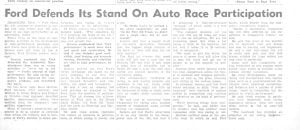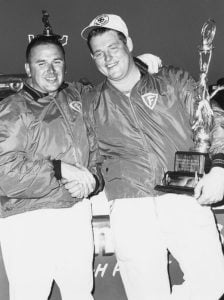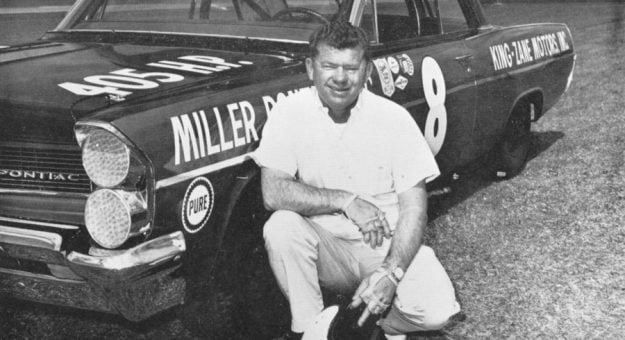Editor’s Note: NASCAR is celebrating its 75th anniversary in 2023. SPEED SPORT was founded in 1934 and was already on its way to becoming America’s Motorsports Authority when NASCAR was formed. As a result, we will bring you Part 16 of a 75-part series on the history of NASCAR as told in the pages of National Speed Sport News and SPEED SPORT Magazine.
“Just change the spelling from N-A-S-C-A-R to F-O-R-D,” quipped General Motors Corporation stock car mechanic Smokey Yunick in the Oct. 2, 1963 issue of NSSN.
Yunick’s frustrated quote came during a string of 18 victories in 26 races for Ford drivers, a run which was capped off by GM’s withdrawal of all support to Pontiac and Chevrolet drivers. This decision by the automaker led Pontiac drivers and former Grand National champions Rex White and Ned Jarrett and top mechanic Cotton Owens to defect to Ford.
In March, Daytona 500 polesitter Glenn “Fireball” Roberts converted to Ford, and by the end of the season, even defending Grand National champion Joe Weatherly changed his ride to a Ford-built Mercury for several races.
Of course, DeWayne “Tiny” Lund’s victory in then-injured Marvin Panch’s Ford in the Daytona 500 did not foretell the manner in which Ford woold emerge in 1963 as the leading choice for stock car drivers. After Lund led a first-through-fifth parade of Fords across the Daytona Int’l Speedway finish line on Feb. 24, drivers in Ford cars only won three races in the next three months.
Ford’s Winning Record
Plymouths, particularly Richard Petty’s, emerged victorious nine times in the next 17 races, with Pontiac and Chevrolet sharing the balance of trips to victory lane. However, Jarrett’s victory in Richmond, Va., on May 19 started Ford’s dominant run, which extended through Panch’s first-place finish at North Wilkesboro (N.C.) Speedway on Sept. 29.
Particularly impressive was Ford’s performance in 250-mile-plus races. Beginning with Dan Gurney’s top finish in Riverside, Calif., Ford drivers grabbed the laurels in 11 of 16 long races. If 1963’s 400-mile-plus races are counted, Ford went seven for nine.

More than winning long races, Holman-Moody and Wood Brothers-prepared Fords — the two primary stock car “builders” were dominating them. After Daytona, Ford-convert Roberts led a 1-2-3 Ford train across the stripe in the Firecracker 400 in Daytona.
Two months later, Roberts headed a top eight of five Fords and three Mercuries in the Southern 500 at Darlington (S.C.) Raceway.
This kind of performance is just what Ford General Manager Lee lacocca had in mind. The March 27 edition of NSSN noted Iacocca’s comments at a Detroit press conference: “High performance is much more than just speed and acceleration. It also includes good roadability (sic), good braking and accurate steering. Durability and reliability are vital to high performance.”
These two factors were also vital in the Ford advertising campaign launched after Lund’s Daytona victory.
The campaign, which included half-page ads in NSSN, featured a picture of a family gathered around their Ford while the text lauded Ford’s durability over many miles of use. With 10 of the 12 Fords entered in the marathon race running at the end, Ford had reason to crow, but they weren’t finished proving their reliability yet.
In the midst of the 18-for-26 streak, Ford rented Daytona lnt’l Speedway for 45 days to test its 1964 Mercury Comets in 100,000-mile durability runs. Beginning on Sept. 21, 34 drivers, including NASCAR notable Buddy Baker, drove 4 hours per day for the 38 days needed to complete 100,000 miles in each of the four Comets.
In doing so, the 271-horsepower cars averaged a record 100 mph, strengthening Ford’s advertised claims.
Non-Ford Drivers Still Find Success
Ironically, in this Ford-dominated season, Weatherly’s dream of a second consecutive Grand National championship came behind the wheel of a 1963 Pontiac “Ford-eater” with which he garnered three victories and four of his six poles.

Swayed by Ford’s mid-to-late-season success, Weatherly switched to Mercury for several races and earned two poles, but he returned to Pontiac to capture the Oct. 27 race in Hillsboro, N.C., and the season title.
Another successful non-Ford driver was point runner-up Richard Petty, who had a more spectacular year than the champion. Petty led 29 races in his 1963 Plymouth, 14 at the finish line, including the Martinsville (Va.) Speedway 500-lapper after which he collapsed from fatigue in victory lane.
Beyond the better-known Petty and Weatherly, third-place Fred Lorenzen pushed a 1963 Ford to a record year, earning $122,588, more than $47,000 more than the Grand National champion.
The golden-haired ex-carpenter from Chicago nailed nine poles and six victories on the season, which included coasting the final lap with an empty fuel tank for the World 600 crown.
Modified driver Eddie Crouse and sportsman pilot Rene Charland reigned for the second year in a row.
Also, $100,000-man Lorenzen was the most popular driver and Billy Wade became the rookie of the year in 1963.
